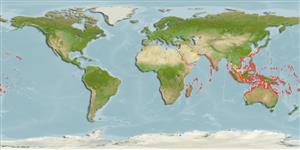Teleostei (teleosts) >
Eupercaria/misc (Various families in series Eupercaria) >
Labridae (Wrasses) > Corinae
Etymology: Hologymnosus: Greek, holos = full + Greek, gymnos = naked (Ref. 45335).
More on author: Lacepède.
Environment: milieu / climate zone / depth range / distribution range
Ecology
Marine; reef-associated; depth range 1 - 35 m (Ref. 30874), usually 5 - 30 m (Ref. 27115). Tropical; 25°C - 28°C (Ref. 27115); 32°N - 30°S
Indo-Pacific: East Africa south to southern Natal, South Africa (Ref. 4392) and east to Samoa and the Line Islands.
Size / Weight / Age
Maturity: Lm ? range ? - ? cm
Max length : 50.0 cm TL male/unsexed; (Ref. 30573); common length : 38.0 cm TL male/unsexed; (Ref. 30573)
Inhabit seaward reefs, in areas of mixed sand, rubble and coral (Ref. 9710) to at least 30 m depth (Ref. 9823). Juveniles seen in groups near the bottom while adults found high above the bottom (Ref. 9710). Juveniles and females usually in small groups. Males solitary and territorial, patrolling large sections of reefs (Ref. 48636). Feed mainly on fishes (about 50%, Ref. 5503) and crustaceans (shrimps) and to a lesser extent on brittlestars and polychaetes (Ref. 1602). Minimum depth taken from Ref. 90102.
Life cycle and mating behavior
Maturity | Reproduction | Spawning | Eggs | Fecundity | Larvae
Oviparous, distinct pairing during breeding (Ref. 205).
Randall, J.E., G.R. Allen and R.C. Steene, 1990. Fishes of the Great Barrier Reef and Coral Sea. University of Hawaii Press, Honolulu, Hawaii. 506 p. (Ref. 2334)
IUCN Red List Status (Ref. 130435)
Threat to humans
Harmless
Human uses
Fisheries: minor commercial; aquarium: commercial
More information
ReferencesAquacultureAquaculture profileStrainsGeneticsElectrophoresesHeritabilityDiseasesProcessingNutrientsMass conversion
Tools
Special reports
Download XML
Internet sources
Estimates based on models
Preferred temperature (Ref.
123201): 24.7 - 28.9, mean 27.6 °C (based on 886 cells).
Phylogenetic diversity index (Ref.
82804): PD
50 = 0.5625 [Uniqueness, from 0.5 = low to 2.0 = high].
Bayesian length-weight: a=0.00490 (0.00204 - 0.01176), b=3.11 (2.90 - 3.32), in cm total length, based on LWR estimates for this (Sub)family-body shape (Ref.
93245).
Trophic level (Ref.
69278): 3.8 ±0.57 se; based on food items.
Resilience (Ref.
120179): Low, minimum population doubling time 4.5 - 14 years (Preliminary K or Fecundity.).
Fishing Vulnerability (Ref.
59153): Moderate vulnerability (40 of 100).
Nutrients (Ref.
124155): Calcium = 43 [23, 71] mg/100g; Iron = 0.484 [0.277, 0.916] mg/100g; Protein = 18.3 [15.3, 20.4] %; Omega3 = 0.0836 [, ] g/100g; Selenium = 34.5 [18.9, 66.4] μg/100g; VitaminA = 91.5 [27.9, 344.7] μg/100g; Zinc = 1.21 [0.83, 1.85] mg/100g (wet weight);
